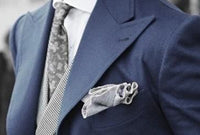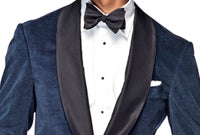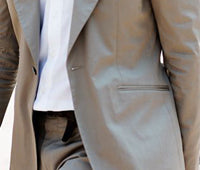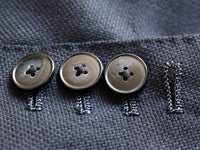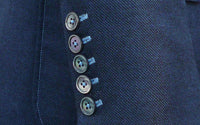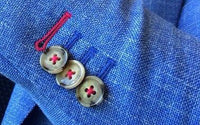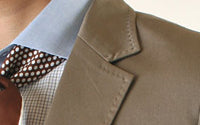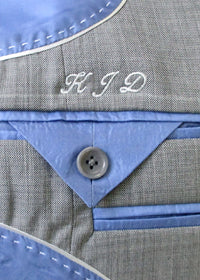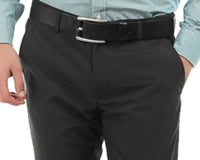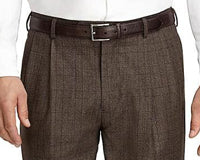Suit Tailor Help
LAPEL STYLE

The lapel is a very noticeable feature of your jacket and will set the style.
* If in doubt, go for notch lapel
|
NOTCHNotch has a small cut between lapel and top collar. This is the standard suit lapel. |
PEAKPeak lapel has tips pointing upwards. It is more visually notable. |
SHAWLShawl collars are rounded and predominantly used for tuxedos. |
LAPEL WIDTH

Please note in the comment section at the end if you wish to specify a non-standard lapel width.
* If in doubt, go for 3”
|
STANDARD - 7.5cm
|
SLIM - 6.5cm
|
LAPEL BUTTON HOLE

* If in doubt, go for a working button hole
|
DECORATIVEDecorative means a button hole has been stitched on your lapel, but has been left closed. |
WORKINGA working button hole allows you to wear a flower or boutonniere. It is the classic option and holds no obvious downside compared to decorative. |
WITHOUTNo button hole gives a very clean look, but is less common. |
STYLE

Single-breasted means one vertical row of buttons. Double-breasted means two vertical rows of buttons (front fastened across other side).
* If in doubt, go for single breasted, 2 buttons
|
SINGLE BREASTED
|
SINGLE BREASTED
|
SINGLE BREASTED
|
DOUBLE BREASTEDDouble-breasted is more formal and suits a slimmer man, as it appears to add width. Six button, two close is the normal option, while other configurations can give interesting looks. |
POCKET STYLE

Flapped denotes fabric covering the pocket opening. Piped has a straight line, without covering flap. Straight or slanted (cut at a slight angle) is a personal choice. Straight is most common, while slanted creates a more ‘flowing line’ through the torso.
* If in doubt, go for flapped straight
|
STRAIGHT FLAPPEDStraight flapped is the most common option, appropriate for all suits. |
SLANTED FLAPPEDSlanted flapped gives a slight twist to the classic flapped pockets. |
STRAIGHT PIPEDStraight piped is the way to go for tuxedos, as it makes the pockets less visible. |
SLANTED PIPEDSlanted piped is an option for those who want something out of the ordinary. |
|
PATCH POCKETSPatch pockets are sewn on the outside of the body of the jacket and are very informal. Great for blazers. |
PATCH POCKETS (FLAPPED)Patch pockets with flaps are even more casual and should essentially be reserved for safari suits. |
NONENo pockets is clean but uncommon. |
TICKET POCKET

* If in doubt, skip the ticket pocket
|
WITHOUTNo ticket pocket is the standard option. |
WITHThe ticket pocket is a small extra pocket above your right pocket. It is a traditional feature which adds more detail, but arguably makes the suit less ‘clean’. |
SLEEVE BUTTONS

Working button cuffs means you can unbutton them. This is a traditional bespoke detail, rarely found off-the-rack (perhaps leave the last one open to show your sartorial flair?).
* If in doubt, go for standard working
|
STANDARD NON-WORKINGThe standard button arrangement has the sleeve buttons lined up and just-touching. Non-working means the button holes will not be opened. |
STANDARD WORKINGStandard working is our most popular option. |
KISSING NON-WORKINGKissing buttons are sewn on with a slight overlap. Some people prefer this look. Non-working means the button holes will not be opened. |
KISSING WORKINGKissing working is a great bespoke detail, but the buttons may sit somewhat less neatly lined up than the other options.
|
SLEEVE BUTTON NUMBER

* If in doubt, go for four
|
THREEThree buttons is a good choice for a shorter gentleman, as it will make your arms look longer. |
FOURFour buttons is the classic option. |
VENTS

Vents offer increased movement and avoid the fabric bunching when sitting down.
* If in doubt, go for side vents
|
CENTER VENTCenter vent is the ‘Italian style’, ideal for slim men and to hide larger buttocks. |
SIDE VENTSSide vents is the ‘British style’, ideal for those who prefer maximum range of motion and easy access to pockets. The two vertical lines in the back give a slimming effect. |
NO VENTNo vents are typically only seen on tuxedos. |
BUTTONS

|
COROZOOur suits come standard with natural corozo nut buttons. They are made from a South American nut, which gives them a natural character. Typically matching buttons are used on formal suits. However, contrasting buttons can be a nice (and bespoke style) detail on suits, e.g., brown buttons on a blue suit can look great, especially worn with brown shoes. |
HORNThe premium option is horn, which is the traditional bespoke button of choice. Horn buttons all look distinctly different, adding further character to your garment. |
BONEBone buttons are more casual looking and make for a slightly more fashionable business suit button. |
SHELLShell buttons are made from Troca mother-of-pearl and have a distinct shine. This is also a premium – and expensive-looking – option, but also one that stands out and consequently gives a more special appearance. |
CONTRAST SLEEVE BUTTON HOLES

This is a chance to personalize your suit with an accent color, but it stands out and is not quite appropriate for business suits.
* If in doubt, skip the contrast
|
NONENo contrast is obviously the safe choice. |
ALLAll button holes contrasting will be very visible and should be considered a casual style. |
LAST ONELast one is a small detail which can look good. Just make sure that you don’t end up wearing ties of just that one color. |
OUTSIDE PICK STITCHING

Outside pick stitching is a line of matching-color stitches following the outline of your lapel. On certain fabrics, outside pick stitching can look very good (typically on either very fine or on heavily textured fabrics), however it does look less ‘clean’.
* If in doubt, skip the pick stitching
|
WITHOUT |
MATCHING |
LINING


We exclusively use Bemberg linings, derived from natural fibers, which makes them breathable. These are generally considered the best in the world and offer superior features compared to polyester, while providing far better durability than silk.
The classic option is a matching or tonal lining, but we have plenty of colorful options for those who want to give their suit some character.
PIPING

Optional line of fabric at the seam joining the lining and front piece of the jacket.
Personal preference. This is a chance to make your suit your own.
* If in doubt, skip the piping
|
NONENo piping provides a more classic look. |
COLOR CHOICEChoose from one of the following colors: 
|
INSIDE PICK STITCHING

Optional decorative line of stitches along the lining, just inside the piping. Can match or contrast the piping and/or lining, or be omitted.
* If in doubt, skip the pick stitching
|
NONENo pick stitching makes for a cleaner look. |
COLOR CHOICEChoose from one of the following colors:  |
MONOGRAM

CHARACTERSAdding a monogram is a nice touch to show that the suit was specifically made for you. It is placed above your left inside pocket and may contain up to 25 characters. These characters can be: |
FONTChoose one of the following fonts:
|
COLORYou can choose to match or contrast any component of the suit, or go for a tonal color for a subtle accent. Select one of the following colors:
|
|
FRONT POCKETS

* If in doubt, go for standard pockets
|
STANDARDStandard pockets are cut at a slight angle. |
SEAM POCKETSeam pockets follow the side seam. They are more difficult to access and are typically reserved for tuxedos. |
NONENo pockets is a very unusual option. |
BACK POCKETS

Back pockets are a personal preference. Even if you don’t use back pockets, at least one is advisable to avoid the back of your pants looking feminine.
* If in doubt, go for left and right
|
RIGHT |
LEFT |
RIGHT AND LEFT |
NONE |
POCKET BUTTON

* If in doubt, go with buttons
|
WITH BUTTON |
WITHOUT BUTTON |
PLEATS

Pleats create a more voluminous trouser through bunching bits of fabric with one or two seams on either leg just below the waist. Pleats are not considered contemporary fashion.
No pleats should be the go to option, as it creates a nice sleek look. Also known as ‘flat front’ (the pants are still pressed with a crease).
* If in doubt, go without pleats
|
WITHOUT PLEAT |
SINGLE PLEAT |
DOUBLE PLEAT |
CUFFS
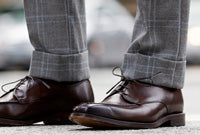
Cuffs, or turn-ups, are a classic feature, which give extra detail to your pants, at the cost of making them less ‘clean’. With little practical function, this is a choice only for those who like the look.
* If in doubt, go without cuffs
|
WITHOUT |
WITH |
BELT LOOPS

* If in doubt, go with belt loops
|
WITHIf you normally wear a belt, you need belt loops. This doesn’t mean that you necessarily have to wear a belt, but you have the option. |
WITHOUTNo belt loops is rather unusual, only appropriate for clothes you would never use belt with, such as tuxedos. |
SIDE FASTENERSide-fasteners are a classic detail, which allows you to pull the tab to decrease the waist size a little bit. It’s not as secure as a belt, however, so it functions more as a visual detail, evoking vintage style. |
FRONT CLOSURE

* If in doubt, go for clip and button
|
CLIP AND BUTTONBy far the most common choice is clip and button, which has a button on the outside, a clip inside and an additional button inside, to keep your pants securely closed. |
CLIP ONLYIf going for a more formal look where a button is not appropriate, go for clip only. Recommended for tuxedos.
|
BUTTON ONLYButton only makes a waistband that does not overlap at the closure, which is a more casual style appropriate for cotton chinos, for example.
|
Body Shape
Body shape is a generalisation of your body type. It gives us an idea of how to interpret your measurements.
Shoulders
Average shoulders have a slope that is not overly pronounced.
Sloped shoulders have a very prominent slope, if it is not that noticeable please select average.
Square shoulders are horizontal. If there is a little bit of slope please select average.
Stomach
Flat means your stomach does not protrude past your chest if you look down.
Average means you can look down and see a little bit of stomach past your chest.
Extended means your stomach protrudes noticeably past your chest.
Back
Straight back means there is very little or no curve from your shoulders to your lower back.
Average means that there is a curve from your shoulders to your lower back.
Curved means there is a large curve from your shoulders to your lower back.
Measurements
Body Measurement is our guide that will help you take your measurements. It is easier to have a friend help and you will need a tape measure.
Garment Measurement is our guide that will help you measure a shirt that fits you very well. It is our recommended method and you will need a tape measure.
Standard size just means that we will use standard US sizes to make your shirt whilst taking your body type into consideration.
Fit
Slim fit is a modern look. Fits the body quite closely with tighter sleeves.
Standard fit is a classic look. Fits the body without appearing tight or restricting.
Loose fit can appear casual but affords maximum comfort and movement.




